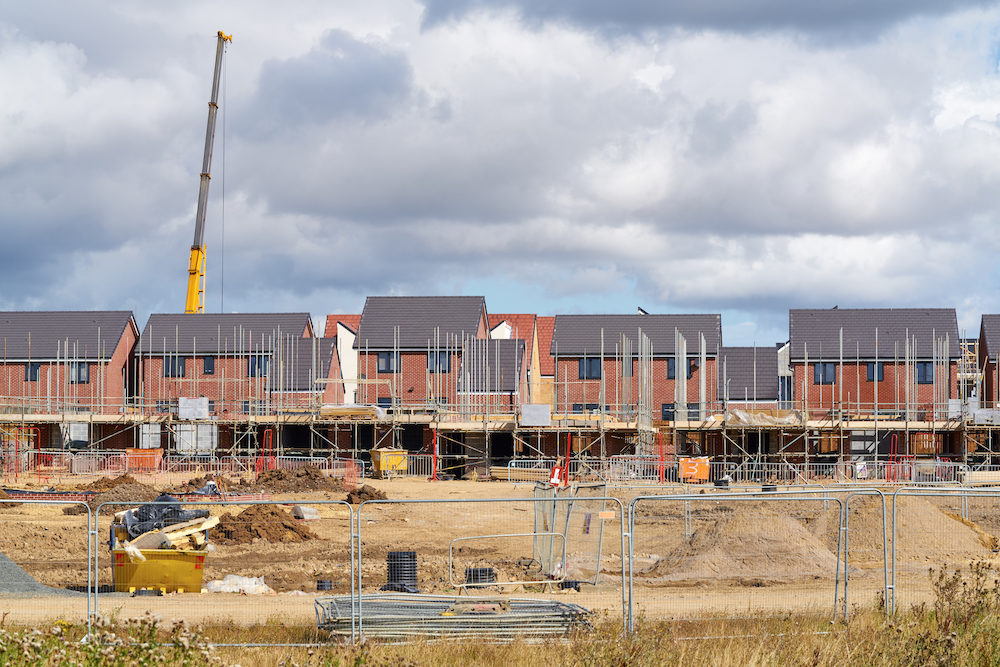
by Kim Pidgeon | Jan 14, 2024 | News
The housing association plans to build 200+ homes on the site
Bromford Housing Association has announced its largest land deal to date.
The social landlord has signed a contract for a multimillion pound land purchase of a 19.5-acre site in Matson, Gloucestershire.
Bromford plans to deliver over 200 homes on the land, which is close to the M5 motorway.
The site already has outline permission for 217 homes, which was granted by Gloucester City Council in April 2021.
The association, which owns and manages more than 46,000 homes across the West Midlands and West of England, is aiming to submit a full planning application for a mixed tenure development comprising around 50% rental homes plus shared ownership and outright sale, to the city council by the summer.
Operations director Robin Smith said: “We’re thrilled to have secured this land which offers the promise of providing homes to hundreds of families. It’s our biggest land purchase deal to date and demonstrates our growing ambitions to invest in more large-scale projects which allow us to make a bigger impact in the community.
“Over the months ahead we’ll be focused on drawing up plans to create a vibrant community of modern, energy efficient homes where our customers can thrive. Subject to planning permission, our in-house construction team will lead on the development of the site.
“This is a great start to the new year and we are also progressing further deals to secure even more land so we can continue to provide much-needed affordable housing across the region.”
The Matson site is less than a mile from Bromford’s previous biggest land purchase at Snow Capel, where planning permission was granted last year to build 180 new homes. Work on this site is due to start later in the year.
The association’s in-house construction team has also started work on a 100-home development in Winchcombe, Gloucestershire during the past six months.
Bromford, which is the biggest social landlord in Gloucestershire, says its ambition over the years ahead is to reduce its reliance on section 106 agreements and to lead on more of its own developments – as with the land at Matson.

by Kim Pidgeon | Dec 30, 2023 | News
Published results show the number of housing starts on site and completions
11,530 new houses were started and 11,297 new homes were completed from housing programmes delivered by Homes England between 1 April and 30 September 2023.
The figures in the official housing statistics report represent a decrease in both starts and completions compared to the same period in 2022.
The report points out that while actual numbers were lower, a higher percentage of starts on sites were for affordable homes than in the same period last year (86% and 74% respectively).
It states this is largely due to the living cost and mortgage rate increases associated with an economic downturn that typically results in a fall in market housing demand, but an increase in affordable housing demand.
Therefore, while the number of starts and completions fall, the decline is less pronounced within affordable housing.
Of the affordable homes started in this period:
- 1,058 were for Affordable Rent (a decrease of 51% on this period last year)
- 1,182 were for Intermediate Affordable Housing Schemes, including Shared Ownership and Rent to Buy (a decrease of 32%)
- 722 were for Social Rent (a decrease of 14%)
It’s worth noting the tenure is still to be confirmed for a further 6,965 of the affordable homes starts (an 11% increase on this figure for the same period last year). This is because providers are not contractually required to identify the tenure of a unit until completion.
Of the 11,297 housing completions from 1 April to 30 September 2023, 7831 were for affordable homes. For the same period in 2022, 7,905 affordable homes were completed – proportionally 2023 represents an increase (69% versus 64% respectively).
Of the affordable homes completed in this period:
- 3,092 were for Affordable Rent – a decrease of 16% from the same period last year
- 3,084 were for Intermediate Affordable Housing Schemes – an increase of 1%
- 1,174 were for Social Rent – an increase of 4%
- The remaining 481 were for First Homes – an increase of 1,103% on 40 First Homes completed in the same period last year.
Peter Denton, chief executive at Homes England, said: “The current economic downturn, with escalating interest rates, abnormal inflation, particularly in building material costs, and the growing cost of living crisis, have all had an impact on housing delivery.
“As the government’s housing and regeneration agency, we have acted as quickly as we can, working with the Department for Levelling Up, Housing and Communities to introduce flexibilities and ease the strain on our partners. We know that these pressures are likely to continue, and we shall continue to work with our partners and central government to support the sector to keep building.
“Times are tough and I’d urge existing and potential partners from the building industry, home providers, developers, investors and local authorities to engage with the Homes England team. We are here to help unlock solutions to problems and pave the way for more homes and regenerated places where people want to live and thrive.”
National housing statistics are published twice a year showing half and full year starts and completions as part of planned national statistical releases.
The next release is full year starts and completions, which are due to be published in May or June 2024.
Homes England programmes are funded by central government to enable private registered providers, house builders, community groups and local authorities to deliver affordable housing.

by Kim Pidgeon | Dec 14, 2023 | News
The housing association have phased our their programmes but will continue to provide support services
After more than 30 years, A2Dominion has completed its withdrawal from providing care services and will refocus on core housing objectives.
The London and southern-England-based housing association owns or manages over 38,000 homes and has 1748 homes in development.
The social landlord, who provided domiciliary care services for more than three decades, began phasing out four programmes in Berkshire and Surrey at the start of 2023 amid what it describes as ‘growing challenges faced by the wider care sector’.
Michael Reece, chief property officer at A2Dominion, said: “We’d like to thank all our colleagues, partners and everyone else involved in helping us to deliver high-quality care services to our customers over many years.
“It was not a decision we took lightly and as a housing association with a social purpose we remain committed to helping those in vulnerable circumstances in any way we can, including through retirement living, our supported services and community investment programmes.
“Looking ahead our core focus remains unchanged and we will continue to work hard to deliver for all our customers and provide homes people love to live in.”
The HA says its Specialist Housing team will continue to provide vital support services, including for young people and parents, students and key workers, as well as those at risk of domestic abuse and homelessness.
As part of the business changes, a new director will be appointed to lead the Specialist Housing team, with the existing post-holder Jo Evans moving to become the first Director of Repairs and Maintenance.
The G15 housing association commissioned a review into its care and support services in 2022 against a backdrop of growing pressure on the wider sector over funding and labour.
It says: “The Group board made the tough decision to exit amid the squeezed margins involved in delivering front-line services.
“In our new corporate strategy, we outlined our commitment to providing value-for-money to customers, stakeholders and investors, and we were not prepared to compromise on the quality of service.”
A2Dominion says it worked closely with the local authorities in Reading, Spelthorne and Woking to ensure a smooth transition of its domiciliary care provision that provided personal care and practical support, including assistance with medication, to those in need.
The four tenders were transferred to new providers at the natural end of the contract and the business retains a significant interest in services going forward as it continues to manage the buildings where care is provided.

by Kim Pidgeon | Nov 29, 2023 | News
Becoming a subsidiary will allow for more investment in both existing and new homes
Johnnie Johnson Housing (JJH) are set to join with fellow not-for-profit housing association Sanctuary, following approval from both organisations’ Boards for JJH to become a subsidiary.
Following due diligence, the results of which were presented to the Boards for consideration, a joint announcement of the deal was made on Monday 27 November.
JJH provide affordable homes across the UK’s northern regions and currently have a portfolio of almost 5000 homes. Sanctuary, who provide housing and care across England and Scotland, own and manage around 120,000 units of accommodation.
The completion of the merger will now be subject to obtaining the appropriate consents from the organisations’ lenders.
Speaking about the new partnership, Sanctuary’s group chief executive Craig Moule said: “Not-for-profit housing and care providers deliver a vital public service to society – we invest in maintaining and improving housing stock, provide a security of tenure that is affordable, develop new affordable homes and deliver good-quality care.
“There is space for organisations of any size in our sector and there are many organisations who provide excellent services to a single community, or a small number of neighbouring communities, but do not have the capacity to make significant investment in their existing homes or develop new homes.
“As one of the largest providers in the sector, we use our size and strength to invest and develop, to be efficient, while maintaining local, community-focused services.”
Yvonne Castle, Johnnie Johnson Housing chief executive, added: “We always look to provide the best possible service and make sure we are focused on what matters most for our residents – providing homes that they love to live in.
“We always want to do more. We are ambitious as experts in the field of providing homes and services, including Astraline’s Technology Enabled Care, for older residents. We know that through joining Sanctuary we will be able fulfil our ambitions and invest more in our residents’ homes than we could on our own.
“As always, the interests of our own residents and those of Sanctuary will remain our top priority.”
Yvonne Castle will leave her role in December, with Kathryn Fox-Rogers to lead the JJH subsidiary in the role of managing director.
Castle added: “I have built a hugely positive relationship with Craig and his colleagues over the last nine months and firmly believe the merger will benefit both organisations. It has been an absolute honour and a privilege to be JJH’s leader and I know that our residents and our colleagues are in great hands as the two organisations move forward together.”

by Kim Pidgeon | Nov 15, 2023 | News
Report shows increase in all types of empty homes since the pandemic
The number of long-term empty homes has increased nationally by nearly 10 per cent since 2018, according to a new report commissioned by the Local Government Association (LGA) and the Empty Homes Network.
The increase – of nearly 60,000 homes since 2018 – is the equivalent of just over one per cent of the country’s housing stock.
The findings, which come at a time of critical housing need, reveal that the numbers across all definitions, types and tenures of empty homes have risen steadily since the pandemic and have largely exceeded the figures seen in 2018.
More than one million properties across England in 2022 were unoccupied, 4.01 per cent of all dwellings.
The rise comes despite the introduction of an empty homes premium in 2013, aimed at encouraging owners to bring empty properties back into use.
The report states many of the empty homes are yet to have reached a stage of deterioration that prompts concern or encourages decline but every empty home removes a property from the housing market.
The rise comes amid the wider background of frozen Local Housing Allowance (LHA) rates, the rising cost of living, the closure of Afghan bridging hotels, wider asylum and resettlement pressures, and an insufficient supply of affordable housing – all driving increases in homelessness and reducing councils’ ability to source suitable accommodation.
The data shows there are currently more than one million people on council housing waiting lists and 104,000 households living in temporary accommodation.
Councillor Darren Rodwell, housing spokesperson for the LGA said: “At a time when we face a chronic housing shortage across the country it is wrong for so many homes to be left empty.
“Councils work hard to address the issue, but the existing measures are clearly falling short. This report, and the best practice proposals and recommendations within it, aim to support councils in their efforts to reduce the numbers of empty homes, increase housing supply, encourage inward investment, and provide a better quality of life for residents and neighbours affected by the issues empty homes cause.
“Councils share a collective national ambition to tackle local housing challenges. The Government should also support this ambition by using the Autumn Statement to implement our six-point action plan so that councils can resume their historic role as a major builder of affordable homes.”
Adam Cliff, secretary and policy lead for the Empty Homes Network, said: “Empty Homes are a hugely wasted resource, and at over one million empty homes nationally, this figure represents the equivalent to the number of total dwellings in the city of Manchester.
“At a time where the demand for housing is so high, working to bring empty homes back into use can not only support meeting this need, but can encourage inward investment, improve communities and enhance the lives of those who currently live near empty homes.
“This report aims to set a standard from which councils can build a solid foundation to deal with empty homes, and provides practical and evidence based ideas which will undoubtedly prove useful to councils and their officers.
“While the numbers across all empty homes categories have shown an increase over the past five years, the report aims to address this by equipping councils and officers with tools to assist in data cleansing, case progression and the overarching empty homes journey through the case progression flowchart.”
Empty homes are divided into five categories: less than six months empty, long-term empty, empty homes premium, second homes and unoccupied. By definition, an empty home is one that has no permanent occupier or can be defined as a property where the main resident lives elsewhere.
As a standard practice, empty homes that have remained unoccupied for over six months from the moment of being informed by the owner are labelled as long-term empty.
Given their category, these are the most likely to warrant concern and/or investigation by the council.

by Kim Pidgeon | Oct 30, 2023 | News
First grant of its kind after changes to the Affordable Homes Programme
Homes England has awarded a £5m grant from the Affordable Homes Programme to Somerset Council to support the North Taunton Woolaway Project.
The grant allocation is the first of its kind following Homes England’s decision in June 2023 that grant funding from the Government’s Affordable Homes Programme 2021-26 could be used to fund replacement homes, alongside new affordable homes, as part of wider estate regeneration plans.
North Taunton was identified for regeneration as it is an area with some of the county’s highest rates of social deprivation and contains some of the most energy-inefficient homes in Somerset.
The North Taunton Woolaway Project is a site comprising of non-traditional homes that were built using prefabricated reinforced concrete panels instead of traditional brick.
This type of construction is time-limited due to structural issues, therefore, demolishing these existing homes and replacing them is more beneficial. All new homes will be built to low carbon standards and will achieve EPC B or above.
In total, 162 energy-inefficient Woolaway homes will be demolished and replaced with 229 council homes for affordable rent. Homes England will be funding 66 of these new build replacement homes, with the remaining homes funded by Somerset Council.
Jackie Jacob, a director of Affordable Housing Grants said: “This funding is the first grant allocation following the introduction of our new flexibilities to support our partners plans for estate regeneration. The Agency’s new Strategic Plan objectives will support Somerset Council in its ambitions to regenerate North Taunton, an area with some of the highest social deprivation levels in the county.
“The North Taunton Woolaway Project is a signal of the funding open to affordable housing providers to accelerate the regeneration of social housing and help level up communities across the country.
“We encourage all providers and local authorities to come and talk to us as early as possible if they need support to develop their proposals – we’re here to help.”
The regeneration project will be rolled out across four phases, two of which will be part-funded by the Affordable Homes Programme to deliver 100 homes, including a variety of bungalows, flats and houses. The agency’s goal is that that this funding will enable the council to accelerate the delivery of phases three and four.





